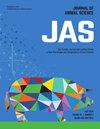美国卡塔丁羊母羊寿命指标遗传参数及遗传趋势的估计。
IF 2.7
2区 农林科学
Q1 AGRICULTURE, DAIRY & ANIMAL SCIENCE
引用次数: 0
摘要
通过直接遗传选育提高母羊的寿命可以提高羊群的盈利能力和动物福利。然而,国家绵羊改良计划(NSIP)目前尚未对长寿指标性状进行评估。因此,本研究的主要目的是利用从国家绵羊改良计划(NSIP)卡塔丁羊群中收集的数据,估计 8 个长寿指标性状的遗传参数。这些母羊(n = 12734)于 1989 年至 2020 年期间出生在全美 58 个羊群中,是 1245 只父本和 6325 只母本的女儿。评估的性状包括最后一次产羔的年龄(ALL)、生产寿命(PL;从第一次产羔到最后一次产羔之间的天数)、产仔总数(TNL)、母羊一生中出生羔羊总数(TNB)和断奶羔羊总数(TNW)、母羊一生中出生羔羊总重量(TLB)和断奶羔羊总重量(TLW)以及 TLW 除以母羊 120 d 调整体重(TLWadj)。使用 AIREML 方法估计变异成分,该方法基于使用血统(A)或混合血统和基因组(H)关系矩阵拟合动物模型。基于 H 矩阵的分析包括了用 50K SNP 芯片进行基因分型的 10,032 头动物的基因组信息。母羊的初产年龄和产仔类型被拟合为固定效应,而同期组(CG:母羊出生的羊群-年份-季节)被拟合为固定效应(CGF)或随机效应(CGR)。利用最佳线性无偏预测(BLUP)或单步基因组 BLUP 获得了血统中 127,535 只动物的育种值及其准确性。根据预测育种值的 CG 类型和方法的所有组合评估了遗传趋势。ALL、PL、TNL、TNB、TNW、TLB、TLW 和 TLWadj 的平均值分别为 1100 日龄、890 日龄、2.7 胎、4.6 只羔羊、4.3 只羔羊、18 千克、70 千克和 2.8 千克/千克母羊体重。根据 AIC 和育种值准确性估计值,H 矩阵的表现优于 A 矩阵。将 CG 作为随机效应拟合时,平均准确值更高。遗传力估计值从 0.06 ± 0.02(TLWadj)到 0.15 ± 0.02(TLB)不等。所有长寿性状之间的遗传和表型相关性均大于 0.80。所有性状的遗传趋势均显著为正,但未观察到实质性的遗传增益。考虑到观察到的平均值和估计的遗传参数,我们建议将长寿作为美国卡塔丁绵羊选育目标的一部分。本文章由计算机程序翻译,如有差异,请以英文原文为准。
Estimation of genetic parameters and genetic trends for ewe longevity indicators in U.S. Katahdin sheep.
Direct genetic selection for increased ewe longevity can improve flock profitability and animal welfare. However, longevity indicator traits are not presently evaluated by the National Sheep Improvement Program (NSIP). The primary objective of this study was, therefore, to estimate genetic parameters for 8 longevity indicator traits using data collected in NSIP Katahdin flocks. Ewes (n = 12,734) were born between 1989 and 2020 in 58 flocks across the U.S. and were daughters of 1,245 sires and 6,325 dams. Traits evaluated were age at the last lambing (ALL), length of productive life (PL; number of days between the first and last lambing), total number of litters (TNL), total number of lambs born (TNB) and weaned (TNW) over ewe lifetime, total lamb birth weight (TLB) and total lamb weight at weaning (TLW) over ewe lifetime, and TLW divided by the ewe's 120 d adjusted body weight (TLWadj). Variance components were estimated using the AIREML method based fitting an animal model using either a pedigree (A) or blended pedigree and genomic (H) relationship matrix. Genomic information of 10,032 animals genotyped with a 50K SNP chip was included in the analyses based on H matrix. Age at first lambing and birth-rearing type of the ewe were fitted as fixed effects, while the contemporary group (CG: flock-year-season of ewe's birth) was fitted as either a fixed (CGF) or random (CGR) effect. Breeding values and their accuracies were obtained for 127,535 animals in the pedigree using either best linear unbiased prediction (BLUP) or single-step genomic BLUP. Genetic trends were evaluated based on all combinations of CG type and method for predicting breeding values. The averages of ALL, PL, TNL, TNB, TNW, TLB, TLW, and TLWadj were 1100 d, 890 d, 2.7 litters, 4.6 lambs, 4.3 lambs, 18 kg, 70 kg, and 2.8 kg/kg of ewe weight, respectively. The H matrix performed better than the A matrix, based on AIC and estimates of breeding value accuracy. Higher average accuracy values were observed when fitting CG as a random effect. The heritability estimates ranged from 0.06 ± 0.02 (TLWadj) to 0.15 ± 0.02 (TLB). All genetic and phenotypic correlations between longevity traits were greater than 0.80. Genetic trends were significative and positive for all traits, but no substantial genetic gains were observed. Considering the observed average values and the estimated genetic parameters, we recommend that longevity becomes part of the selection objectives for U.S. Katahdin sheep.
求助全文
通过发布文献求助,成功后即可免费获取论文全文。
去求助
来源期刊

Journal of animal science
农林科学-奶制品与动物科学
CiteScore
4.80
自引率
12.10%
发文量
1589
审稿时长
3 months
期刊介绍:
The Journal of Animal Science (JAS) is the premier journal for animal science and serves as the leading source of new knowledge and perspective in this area. JAS publishes more than 500 fully reviewed research articles, invited reviews, technical notes, and letters to the editor each year.
Articles published in JAS encompass a broad range of research topics in animal production and fundamental aspects of genetics, nutrition, physiology, and preparation and utilization of animal products. Articles typically report research with beef cattle, companion animals, goats, horses, pigs, and sheep; however, studies involving other farm animals, aquatic and wildlife species, and laboratory animal species that address fundamental questions related to livestock and companion animal biology will be considered for publication.
 求助内容:
求助内容: 应助结果提醒方式:
应助结果提醒方式:


